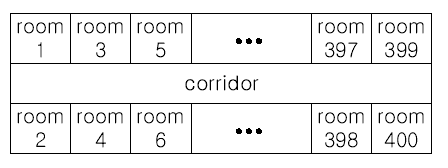Moving Tables
Time Limit: 2000/1000 MS (Java/Others) Memory Limit: 65536/32768 K (Java/Others)
Total Submission(s): 45555 Accepted Submission(s): 14817
Problem Description
The famous ACM (Advanced Computer Maker) Company has rented a floor of a building whose shape is in the following figure.

The floor has 200 rooms each on the north side and south side along the corridor. Recently the Company made a plan to reform its system. The reform includes moving a lot of tables between rooms. Because the corridor is narrow and all the tables are big, only one table can pass through the corridor. Some plan is needed to make the moving efficient. The manager figured out the following plan: Moving a table from a room to another room can be done within 10 minutes. When moving a table from room i to room j, the part of the corridor between the front of room i and the front of room j is used. So, during each 10 minutes, several moving between two rooms not sharing the same part of the corridor will be done simultaneously. To make it clear the manager illustrated the possible cases and impossible cases of simultaneous moving.

For each room, at most one table will be either moved in or moved out. Now, the manager seeks out a method to minimize the time to move all the tables. Your job is to write a program to solve the manager’s problem.

The floor has 200 rooms each on the north side and south side along the corridor. Recently the Company made a plan to reform its system. The reform includes moving a lot of tables between rooms. Because the corridor is narrow and all the tables are big, only one table can pass through the corridor. Some plan is needed to make the moving efficient. The manager figured out the following plan: Moving a table from a room to another room can be done within 10 minutes. When moving a table from room i to room j, the part of the corridor between the front of room i and the front of room j is used. So, during each 10 minutes, several moving between two rooms not sharing the same part of the corridor will be done simultaneously. To make it clear the manager illustrated the possible cases and impossible cases of simultaneous moving.

For each room, at most one table will be either moved in or moved out. Now, the manager seeks out a method to minimize the time to move all the tables. Your job is to write a program to solve the manager’s problem.
Input
The input consists of T test cases. The number of test cases ) (T is given in the first line of the input. Each test case begins with a line containing an integer N , 1<=N<=200 , that represents the number of tables to move. Each of the following N lines contains two positive integers s and t, representing that a table is to move from room number s to room number t (each room number appears at most once in the N lines). From the N+3-rd line, the remaining test cases are listed in the same manner as above.
Output
The output should contain the minimum time in minutes to complete the moving, one per line.
Sample Input
3
4
10 20
30 40
50 60
70 80
2
1 3
2 200
3
10 100
20 80
30 50
Sample Output
10
20
30
这个题真是迷了, 一开始想的就是每次能搬尽量多的桌子,这样就能最快搬完,所以按照区间的右端排的序。
其实这样不是最快的,第一次筛选确实是一次搬得桌子最多,但是还要保证的是进行得次数最少而不等同于每次搬得个数最多, 可能会导致后面次数变多,还要顾及后面的。
例如这组测试数据
Input 1 5 1 20 10 40 30 70 50 60 80 90 Output 20
还在一个地方卡了一会儿, 走廊的相邻奇数和偶数房间是对门的,共享一段走廊,所以奇数被占用时候,对门的偶数也是被占用了的。
所以应该对区间进行处理
data[i].s = (data[i].s+1)/2; data[i].t = (data[i].t+1)/2;
#include <iostream> #include <stdio.h> #include <algorithm> using namespace std; struct dat { int s; int t; int visit; } data[300]; bool cmp(dat a, dat b) { return a.s<b.s; // return a.t<b.t 是错的 } int main() { int t, n; scanf("%d",&t); while(t--) { scanf("%d",&n); for(int i=0; i<n; i++) { scanf("%d%d",&data[i].s, &data[i].t); if(data[i].s>data[i].t) { int temp = data[i].s; data[i].s = data[i].t; data[i].t = temp; } data[i].s = (data[i].s+1)/2; data[i].t = (data[i].t+1)/2; data[i].visit=0; //printf("%d%d ",data[i].s,data[i].t); } sort(data, data+n, cmp); int ans=0, j, temp; for(int i=0; i<n; i++) { if(!data[i].visit) { j=i+1; temp = i; data[i].visit=1; while(j!=n) { if(!data[j].visit&&data[temp].t < data[j].s) { data[j].visit=1; temp=j; } j++; } ans++; } } printf("%d ", ans*10); } return 0; }
另一种思路就是区间覆盖,找覆盖次数最大的点的覆盖次数。